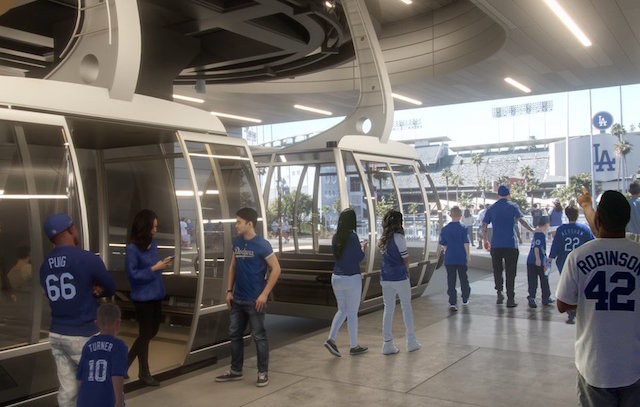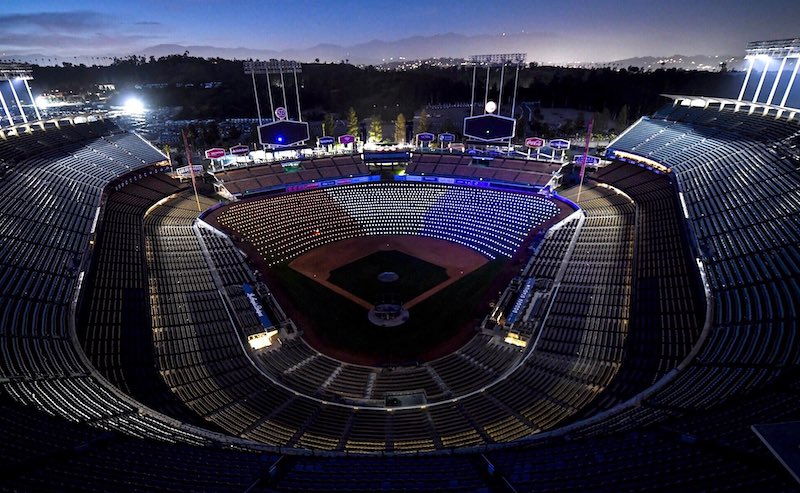Los Angeles City Councilmember Eunisses Hernandez introduced a motion instructing the city to suspend any actions related to advancing the Los Angeles Aerial Rapid Transit (LA ART) until the Department of Transportation completes a thorough assessment of Dodger Stadium traffic and accessibility.
More commonly referred to as the gondola, the plan for LA ART was unveiled by the Los Angeles Dodgers and former team owner Frank McCourt’s company Aerial Rapid Transit Technologies LLC (ARTT) in April 2018. In 2019, it received unanimous approval from the Metro Board of Directors.
The project, which is being funded by McCourt, was backed by former L.A. Major Eric Garcetti and came together under Metro’s Office of Extraordinary Innovation.
However, the project faced mounting opposition from residents living in surrounding neighborhoods and the California Endowment, a nonprofit that argued the project was fast-tracked without public vetting.
Local residents shared concern a Dodger Stadium gondola system would run through their community and take away privacy, but McCourt continued buying property in L.A. neighborhoods and displacing residents.
“I am grateful that Councilmember Hernandez is introducing a motion to suspend the advancement of this gondola until the Department of Transportation considers all the alternatives to reducing traffic and facilitating access to Dodger Stadium,” president of Friends of Elysian Park Phillip Murphy said in a statement.
“It should be noted that the stadium is nestled in Elysian Park, which is a ‘Dark Park,’ meaning it closes down at night to give the wildlife that live there a rest, as well as the neighbors who live nearby.
“If the gondola is operating from 6 a.m. until 12 midnight, which is indicated in the Final EIR, we might as well live next to City Walk for all the peace and quiet we’ll get.”
Proponents of the gondola argued it would decrease traffic and transportation-related population and greenhouse gas emissions as a result of reduced vehicular congestion in and around Chavez Ravine, on neighborhood streets, arterial roadways and freeways.
A draft of the Environmental Impact Report (EIR) by Metro found that roughly 20% of fans could ride the gondola before and after each Dodgers game at Dodger Stadium, reducing vehicle miles traveled as attendees shift from driving to riding transit connected to Metro’s regional transit system.
The EIR also said the lifetime reduction of the vehicle miles would be nearly 130,000,000 VMT, and the project could reduce emissions by over 150,000 metric tons of greenhouse gasses.
The gondola system is expected to carry close to 6,000 riders between Union Station and Dodger Stadium during each game, and that number could jump to 10,000 by 2042.
Although opposition remains, more than 6,000 individuals and 340 businesses in Chinatown, El Pueblo and Lincoln Heights have signed up to support the gondola system.
The EIR is set to be considered by the Metro Board before potentially heading to additional city, county and state agencies for review. Councilmember Hernandez noted the significant pushback from community members and concerns about potential environmental end economic impacts.
In her motion, Hernandez pointed out that the most recent analysis of potential traffic mitigation measures at Dodger Stadium was completed over thirty years ago while the current proposal is being considered in a vacuum rather than weighed against a menu of solutions and how they will solve issues in the present day landscape.
There has been no study from local transit agencies that demonstrates that the gondola will offer a robust solution to the impact of stadium traffic on surrounding communities compared against other zero emission transit solutions such as enhanced and targeted park and ride regional bus systems, improved pedestrian infrastructure, moving escalators and walkways, or other transit technologies.
“The communities that surround Dodger Stadium already bear the burden of the traffic congestion and increased pollution that stems from an increasingly year-round schedule of events at the stadium,” Hernandez said in a statement.
“Now, Metro is asking them to absorb the impact of constructing a gondola that would fly just feet over their homes and fundamentally change the landscape of their neighborhoods, without ever demonstrating that this is the most effective and efficient way to mitigate stadium traffic.
The last analysis was done over 30 years ago. As public agencies, we owe it to our constituents to conduct a real study of this issue and present evidence-based solutions.”
Councilmember Hernandez’s motion instructs city departments to study policies and procedures at other stadiums and high-capacity venues throughout the region, including the Rose Bowl, Hollywood Bowl, SoFi, BMO and the Coliseum, to provide recommendations for how to alleviate traffic, community queuing, and local parking impacts.
“This is the most sensible order of operations to determine the best solutions for traffic congestion around Dodger Stadium,” adjunct assistant professor in the UCLA Institute of the Environment and Sustainability Jon Christensen said.
“The gondola and other alternatives should be studied fairly and objectively to determine what impact they are likely to have on traffic and greenhouse gas emissions as well as their contributions to the city’s overall goals for electrifying our entire transportation system.
“It is unfortunate that this was not done in the environmental impact review for the gondola. But it should be done before considering the gondola proposal in any way.”
The gondola was estimated to cost $125 million when the project was first announced, but AART said those costs have risen. It was originally slated to begin construction in 2022.
AART wants the gondola built in time for the 2028 Summer Olympics, which have also been the center of community pushback. While there are no Olympic events yet planned at Dodger Stadium, the gondola would provide sweeping views of downtown L.A. and the San Gabriel Mountains
The process is currently undergoing Final EIR certification and approval before heading to the Metro Board of Directors. If approved, the final step would be to file a Notice of Determination (NOD), which would start a 30-day period for legal challenge.
How would the Dodger Stadium gondola system work?
The system was designed to provide the first permanent public transit link to Chavez Ravine. It would take an estimated five minutes of travel time.
As proposed, it would be able to move more than 5,000 passengers per hour, per direction and could help with the traffic both around Dodger Stadium and downtown Los Angeles.
Under current plans, each cabin would hold around 30-40 passengers, and the system will serve all Dodgers home games and special events at Dodger Stadium.
It could also possibly operate daily to serve visitors seeking to enjoy the scenic gondola experience. At present time, the existing Metro system only provides a game-day shuttle connection between Union Station and Dodger Stadium.
Have you subscribed to the Dodger Blue YouTube channel? Be sure to ring the notification bell to watch player interviews, participate in shows and giveaways, and stay up to date on all Dodgers news and rumors!










